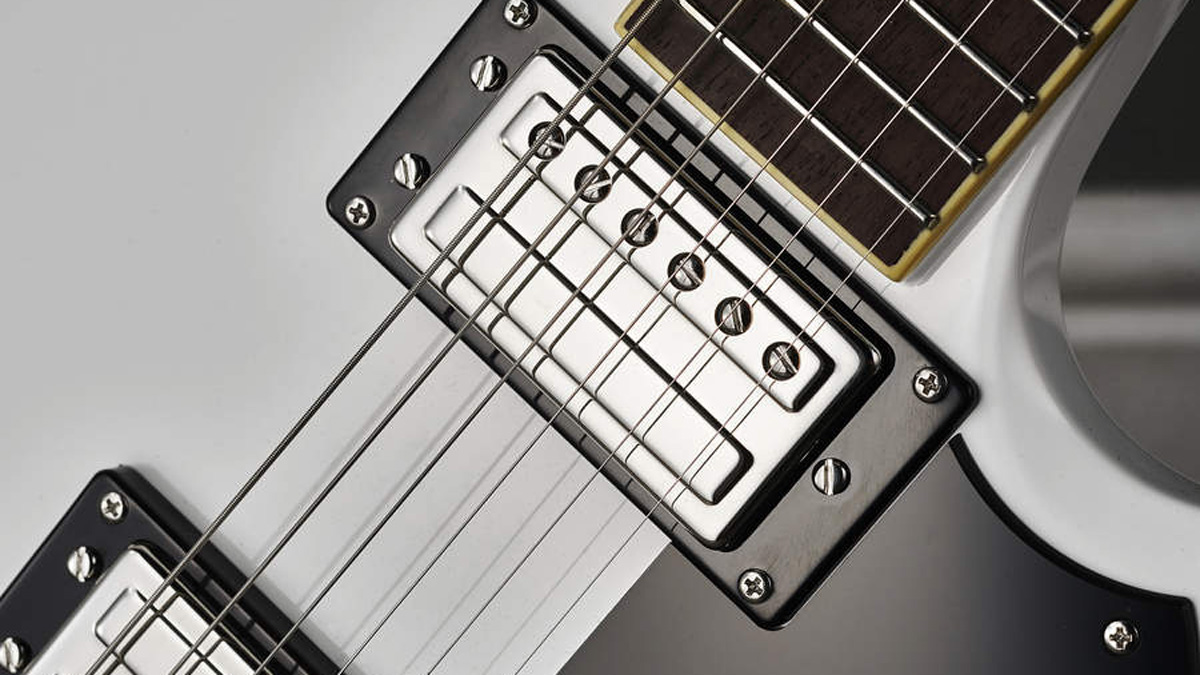MusicRadar Verdict
The S-100, now a cornerstone of modern Guild, raises the bar a little, not just cosmetically but sonically, too.
Pros
- +
Price, ‘deluxe’ style, nice repros of original HB-1 humbuckers, weight and resonance.
Cons
- -
Aside from the fact that Guild no longer produces a case for this guitar, it’s a cool enough piece.
MusicRadar's got your back
Guild was rather late to the electric solidbody market, taking until 1963 before it released a trio: the twin pickup S-200 Thunderbird and S-100 Polara and the single pickup S-50 Jetstar.
While all three models featured asymmetrical three-a-side headstocks they borrowed from previous designs: the S-200 had clear Jazzmaster/Jaguar style, the S-100 and S-50 a more conservative offset dual cutaway shape.
All three had a concave cutaway on their bases, while the S-200 and S-100 even included built-in flip-out stands on their backs. They lasted through the decade, before Guild took a more Gibson SG-like route with its 70s solidbody range.
The 70s-era S-100 Polara was the only solidbody in the relaunched-by-Fender line back in 2013. It was joined in 2016 by the out-there 60s-style S-200 T-Bird (née Thunderbird) followed, in 2017, by a more conventional ‘ST’ version that swapped the Hagstrom vibrato for a regular tune-o-matic and stud tailpiece, along with paring back the T-Bird’s original-style internal circuitry.
It features an all- mahogany construction (hidden under the opaque finish), glued-in neck, pau ferro fingerboard - originally the S-100 had a rosewood ’board but was changed, from mid-2018, to avoid the added complication caused by the latest CITES import/export restrictions - and dual pickup.

The S-100 is still Korean-made like the rest of the Guild Newark Sts (although different factories are used for different models). Meanwhile, the S-100, and most of the other Guild electrics, use a Gibson-style 629mm (24.75- inch) scale. The Newark St. S-100 Polara certainly sticks closely to its 70s incarnation. Offered in a choice of colours, Cherry Red translucent and solid Black and White - all with the same black pickguard and Guild logo - there’s a more deluxe vibe with a cream bound fingerboard, large pearloid block inlays and the classic dome-topped Guild head with that 70s-style solid ‘Chesterfield’ logo.
Sounds
Weight-wise it is no surprise that the svelte Polara is not overdone. The Polara’s neck leaves around the 20th/21st fret and, despite having quite a chunky heel, allows easier access to the top fret, not least with those off-set cutaways. Played seated, the Polara feels like its inspiration, the Gibson SG, in that the neck seems very long.
Want all the hottest music and gear news, reviews, deals, features and more, direct to your inbox? Sign up here.
Profile-wise, the Polara has a relaxed classic C shape. Measuring the fingerboard radius reveals a camber of 305mm/12 inches but, more importantly. The Polara also uses a narrow tall wire (2.24 x 1.35-1.4mm).
Interesting, too, is the acoustic voices: the S-100 has vibrancy in its voice. The open- backed Grover three-a-side tuners on the Polara also feel a little more positive than the marginally softer feeling six-in-a line split post Kluson-style of the recently-reviewed Jetstar.
We’ve discussed the ‘mismatch’ of the Guild LB-1 pickups and we’d suggest you give it a go: raise the bridge nice and close to the strings with a little bass-to-treble tilt and pull the neck down, especially on the bass side, and you’ll easily find a balance. Along with that comes a huge width of sound from the stinging big single coil-like voice at the bridge to the darker, textured neck and a sprightly and vibrant mix that has a lot of Fender in there - maybe the longer scale is adding its mojo?
As a Newark St. Starfire user, this writer feels very at home here - there’s plenty of 60s jangle, that bridge really spanks for instrumental leads yet it can do mellow jazz at neck at the flick of that pickup toggle. The volume and tone work as you’d expect; you damp some highs with volume reduction and the tone takes a while to kick in but neither bothered us in the least.
Plugging in the S-100 we go up a notch in juice. There’s a noticeable PAF-y quality here with a little airy chime evident on both pickups, and the mix. The bridge has depth, it’s more humbucking but in an early sense - it’s far from overwound. The neck, too, while not as such more powerful just has a hint more clarity.
The wiring style plays its part as the volumes are quite sensitive - a small pull back cleans up the sound for some lovely quite single coil-like, snappy blues voices while the tones are a little more useful, certainly with the volume near or fully up. As ever the controls expand the voice considerably: a vintage-y clean ’bucker voice that might lack the heft of a thicker mahogany/maple-topped single-cut but which sits firmly in the classic rock genre. It has more than enough clarity without sounding sterile for gained voices and so long as you use those controls you can access a host of classic sounds.
The S-100, now a cornerstone of modern Guild, raises the bar a little, not just cosmetically but sonically, too.
Dave Burrluck is one of the world’s most experienced guitar journalists, who started writing back in the '80s for International Musician and Recording World, co-founded The Guitar Magazine and has been the Gear Reviews Editor of Guitarist magazine for the past two decades. Along the way, Dave has been the sole author of The PRS Guitar Book and The Player's Guide to Guitar Maintenance as well as contributing to numerous other books on the electric guitar. Dave is an active gigging and recording musician and still finds time to make, repair and mod guitars, not least for Guitarist’s The Mod Squad.

